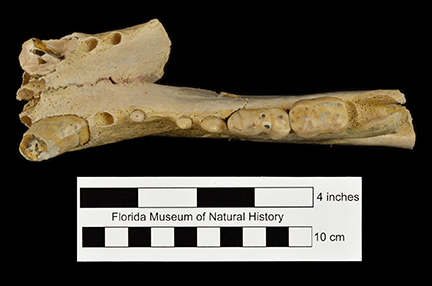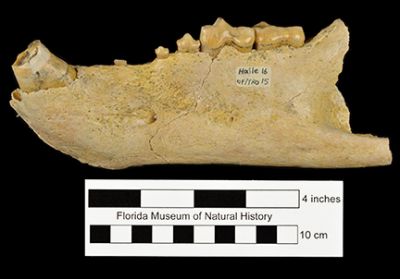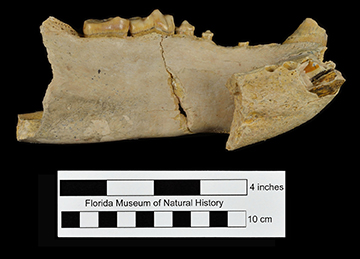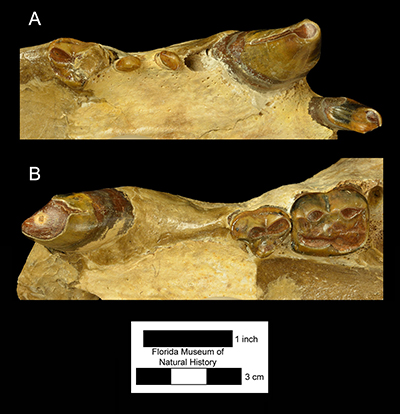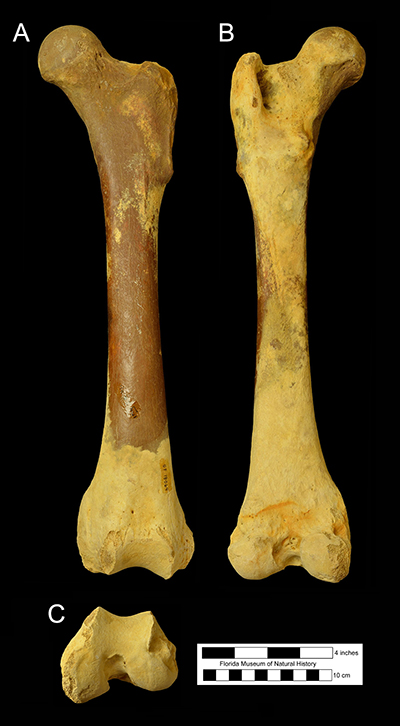Arctodus pristinus
Quick Facts
Common Name: Lesser short-faced bear
Largest land carnivore in Florida during the early Pleistocene.
Among living bears, most closely related to the spectacled bear of South America.
Age Range
- Early to middle Pleistocene Epoch; Blancan and Irvingtonian land mammal ages
- About 2.5 to 0.5 million years ago
Scientific Name and Classification
Arctodus pristinus Leidy, 1854
Source of Species Name: Leidy (1854) did not provide a reason for the species name, but pristinus in Latin means ‘primitive‘ or ‘early’. This name may have been given because Arctodus pristinus was the first Arctodus Leidy identified.
Classification: Mammalia, Eutheria, Laurasiatheria, Caniformia, Carnivora, Arctoidea, Ursoidea, Ursidae, Tremarctinae
Alternate Scientific Names: Ursus haplodon; Arctodus haplodon
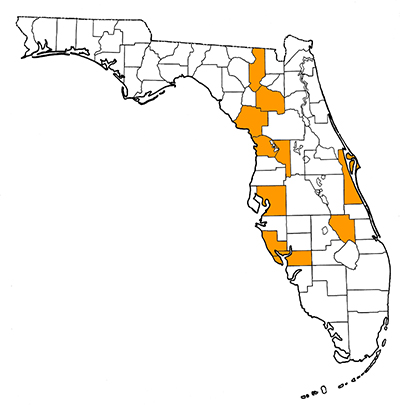
Overall Geographic Range
Florida Fossil Occurrences
Florida fossil sites with Arctodus pristinus:
- Alachua County—Haile 16A
- Brevard County—Sebastian Canal 2
- Charlotte County—Port Charlotte area (specific location unknown)
- Citrus County—Crystal River Power Plant; Inglis 1A; Inglis 1B
- Columbia County—Santa Fe River 1
- Hillsborough County—Apollo Beach; Leisey Shell Pit 1; Leisey Shell Pit 1A; Leisey Shell Pit 3
- Levy County—McLeod Limerock Mine
- Okeechobee County—Kissimmee 6
- Sarasota County—Bass Point Waterway; Rigby Shell Pit; Venice Beach
- Sumter County—Coleman 2A
Discussion
Arctodus pristinus is a large tremarctine bear. More fossils of this species are known from Florida (about 150) than anywhere else. Compared to the gigantic Arctodus simus, the premolars and first molars of Arctodus pristinus are relatively smaller and more widely spaced (Figs 2-5; Schubert et al., 2010). Both species show pronounced intraspecific variation, much of it related to sexual dimorphism, with smaller, more lightly built females and larger, massive males. Males of the smaller species A. pristinus overlap in size with females of A. simus.
There is even greater overlap in size between A. pristinus and the late Pleistocene species Tremarctos floridanus. The molars of A. pristinus are, on average, broader and taller than those of Tremarctos floridanus, but these differences are quickly obscured by wear. Most published comparisons are between the two species of Arctodus, or between A. simus and T. floridanus, and not between the two more similar-sized A. pristinus and T. floridanus. Samples are now available to make such comparisons worthwhile. Although not completely satisfactory, in practice large tremarctine fossils from the early to early middle Pleistocene of Florida can be identified as A. pristinus, while those from the late Pleistocene are considered T. floridanus. Specimens of ambiguous age, unless they include molar teeth that are relatively complete and unworn or only slightly worn, will be very difficult to identify precisely.
The genus Arctodus is generally regarded as being more carnivorous than either Tremarctos or the black bear Ursus americanus. Its large size would allow it to take carcasses away from most other carnivores, especially solitary felids. The bite marks found on many bones of sloths and young proboscideans at Leisey Shell Pit matched the size of the canine teeth of Arctodus pristinus (Pratt and Hulbert, 1995). It is not known if these bite marks are the result of active predation or scavenging.
Sources
- Original Author(s): Richard C. Hulbert Jr.
- Original Completion Date: February 24, 2009
- Editor(s) Name(s): Richard C. Hulbert Jr. and Natali Valdes
- Last Updated On: June 11, 2015
This material is based upon work supported by the National Science Foundation under Grant Number CSBR 1203222, Jonathan Bloch, Principal Investigator. Any opinions, findings, and conclusions or recommendations expressed in this material are those of the author(s) and do not necessarily reflect the views of the National Science Foundation.
Copyright © Florida Museum of Natural History, University of Florida
